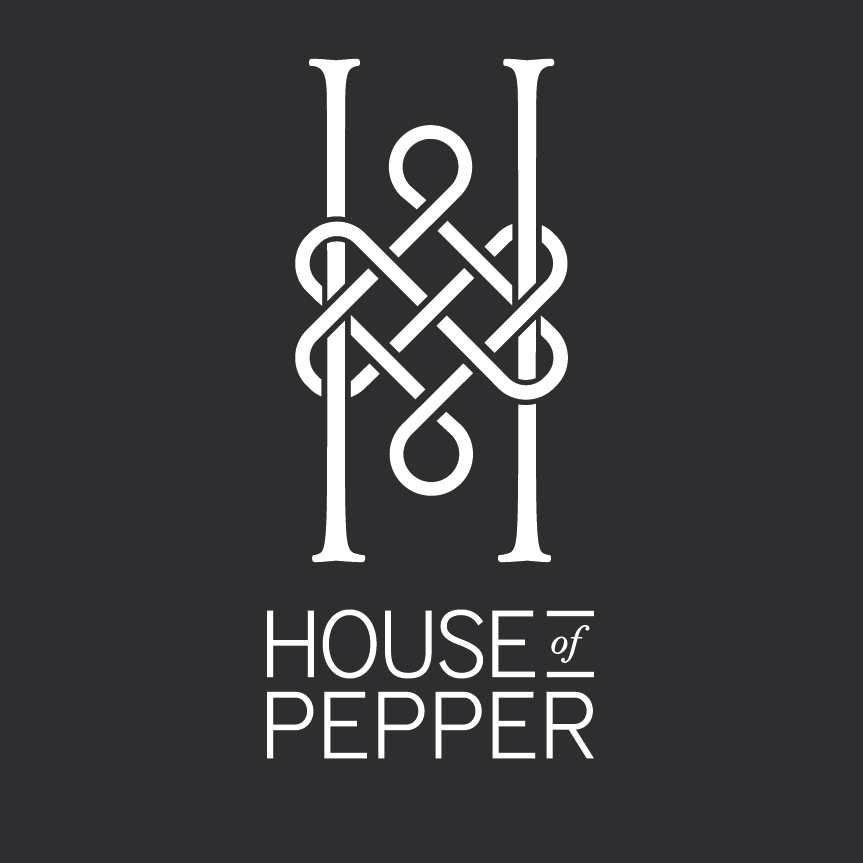Medieval Monks
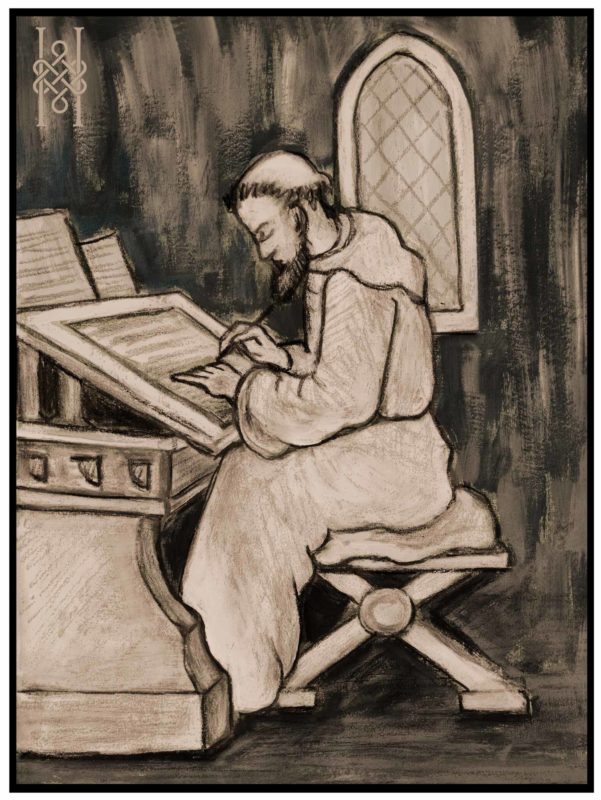
Monastery Monk at work
The libraries in the monasteries in Europe in the Medieval Ages in the 5th century kept education and learning alive. The monks sought a quiet spiritual life at a time when Europe was in isolation and at war. Monasteries kept libraries of classic works and collections of painting and sculpture. Education for the community in many forms was but one duty for the monks, copying religious text in the Scriptorium was another.
My drawing is adapted from an early woodcut print of a monk at work in the Scriptorium copying a manuscript.
St Columba
Columba (521-597), known as Colm Cille in Ireland, went to the west coast of Scotland and to the island of Iona to do penance and escape from the blood spilled in his family battles at home in Ireland. He wanted to get as far away from Ireland as possible and made sure his homeland was not visible from Iona. Despite the dark past which included the illegal copying of the Gospels, he introduced the Christian faith to the community in 563 AD and built a monastery of wood and clay on the island with twelve followers. It seems Columba was a strange character with a dislike for women, cows, frogs and snakes. He banished women from the island of Iona to a nearby island and removed the snakes. He told stories about how he banished a water monster to the River Ness in c 565 after the huge creature killed a Pict. There were miracles like this. The monks were punished if they sang out of key and if they forgot to say Amen at the end of prayers. Other stories abound and may have been made up! The simple cloistered life was not as quiet as hoped with Columba as the Abbot. He died in c 597 and left behind him a conversion to Christianity in Scotland and Northern England. By 800 AD the influence of the Christian Church spread all over Europe.
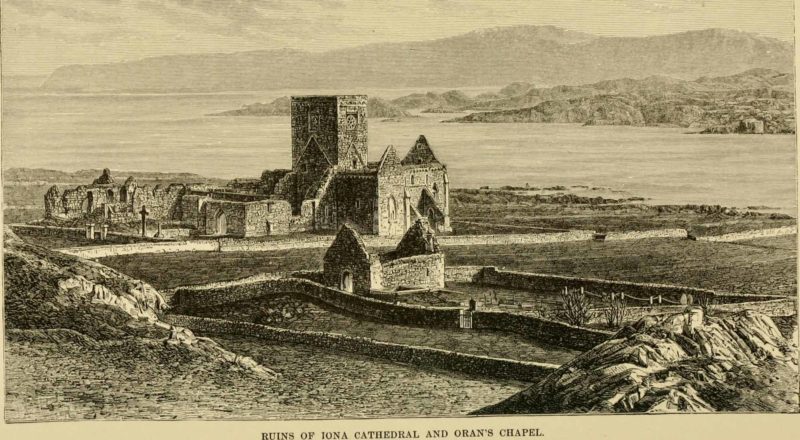
A woodcut of the Iona Monastery Ruins
Celtic Insular Church
The people of Scotland were from pagan beginnings and believed in the spirit in trees, rivers, stones, mountains, and all living things. They believed in their own Gods and Goddesses, and they believed in the Otherworld after death as a perfect place of peace and harmony; a place where departed ones could be revisited and where Gods and Goddesses roamed back and forth through the veil between life and death.
This Celtic Christianity was different. The new religion did not replace what they already knew. Jesus was simply like another God or hero. The early Church melded the pagan and Christian beliefs together and the pagan farming Calendar of festivals and events remained as a part of life. Monks were not isolated from the community and for centuries after Columba died the monks continued to carve Stone Crosses, craft ornaments and produce manuscripts in the decorative Insular Celtic style. Insular meaning island style or new learning from the islands of Britain and Ireland. The most famous- the Book of Kells dated around 800 AD was taken to Kells in county Meath, Ireland at some point, and so survived the Viking raids on Iona in 806 AD which left some 68 people dead.
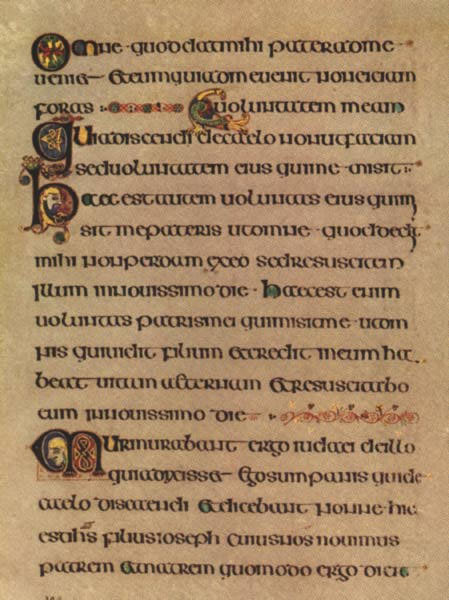
Book of Kells calligraphy in Latin
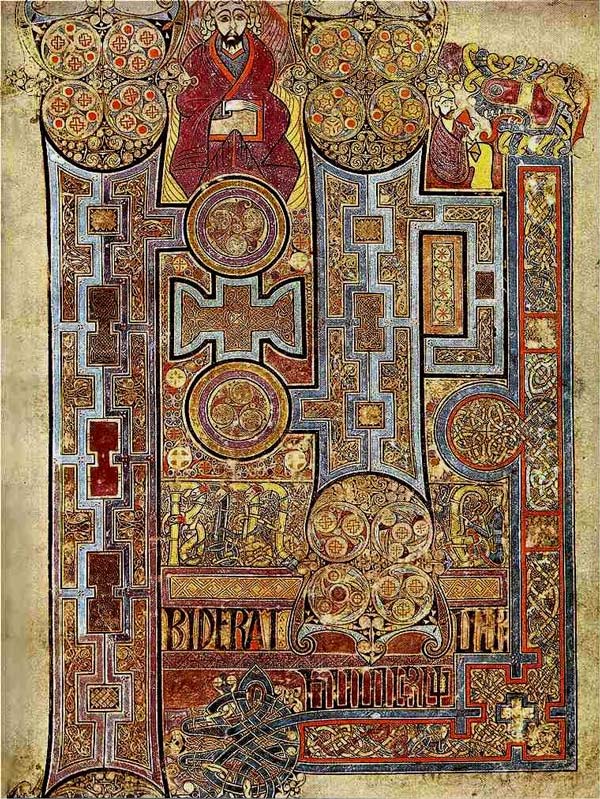
Book of Kells Folio 292r with St John
In this Celtic Church the monks as scribes copied the St Jerome version of the Bible under the instruction of the Abbot. By an amalgamation of the old and the new, decorated text with animals, birds and plants were drawn onto the pages of the Gospels of Lindisfarne and the Book of Kells in the Insular style. For hours, the scribe would sit and copy the Latin text on a sloping desk in the Scriptorium. The quill had to be at right angles to the parchment and was sharpened with a pen knife. Gold leaf was carefully crafted into the initials and letters using gesso and sealed. The distinctive shaved head was called a tonsure and was a common hairstyle for monks.
St Benedict and the Vows of Poverty, Chastity, and Obedience
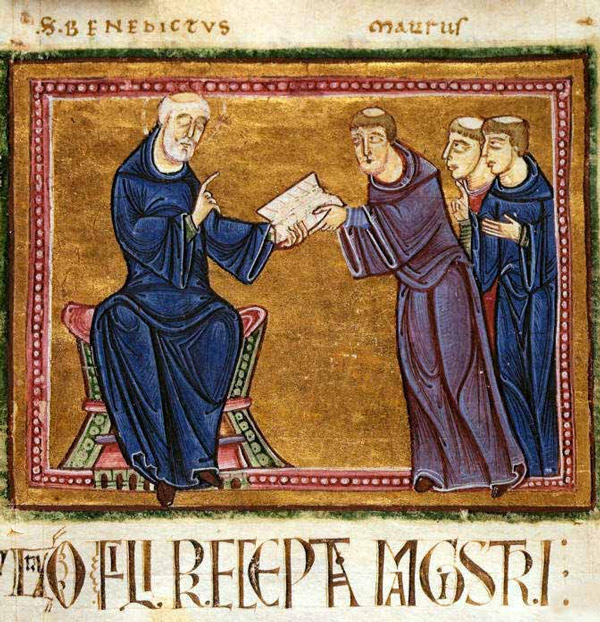
St Benedict delivering his rule to the monks of his order.
Before the Book of Kells and Columba on Iona, the first monk to change and revive the monasteries was St Benedict (480 – 543 AD). He ran from the decadence of Rome and lived in a cave for a while as a hermit. His devotion inspired others and eventually he led twelve other monasteries. St Benedict introduced the famous vows of poverty, chastity and obedience and regulated the life in the monasteries. With the fall of the Roman Empire the monastery monks did whatever they liked, there was no discipline. After St Benedict activities were timetabled; prayers started early in the morning and continued throughout the day. Some monks worked on farms, others helped the sick or the travelers that arrived at the door and some worked in the library and copied the scriptures.
There were many orders of monks after the Benedictines including the Cluniacs, Camaldolese, Carthusians, Cistercians, Franciscans and Dominicans and each had a different character and holy practice. Some monasteries wove their own cloth, made their own wine and pottery, and became carpenters and masons. The community learned skills from the monks and the Monasteries were part of Medieval life with a guesthouse for travelers.
The First Printing Press and Johannes Gutenberg
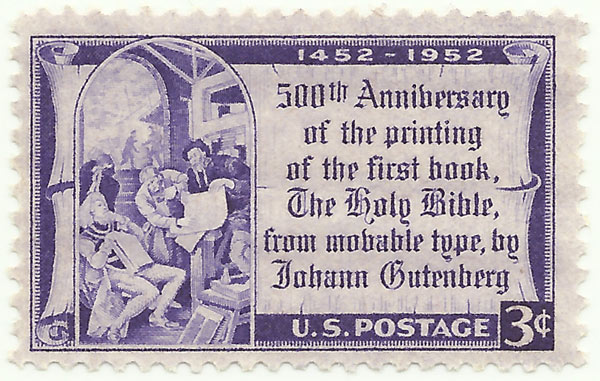
Gutenberg Press commemoration
At this time in the Middle Ages hardly anyone could read. It became known as the Dark Ages and it followed the collapse of the Roman Empire in c 376-476. Up until the year 1200, books were rare. Some books were chained to shelves and locked. Everything was handwritten. It would take about a year to complete one manuscript of the Bible.
It should be mentioned that the Eastern Roman, or Byzantine Empire, based at Constantinople thrived and was not part of this Dark Age in Europe when culture and learning languished.
In the late Middle Ages around 1450, Johannes Gutenberg invented the metal movable-type printing press in Europe. It followed a movable-type porcelain invention in China in 1040. During the Song dynasty in 1161 the first printing on money occurred.
Everything changed with the Guttenberg Printing Press. It was an information revolution even more astounding than the technology age of our recent times. In 1570 the Bible was the first large book to be printed. Information was no longer just stored in Monastery libraries. Other subjects outside religion were recorded and ideas and opinions were spread in printed books. Classical texts were revived and there was a rebirth of knowledge, art and learning. The Renaissance followed the Middle Ages and flourished from the 14th to the 17th century in a new Golden Age.
Martin Luther and the Reformation
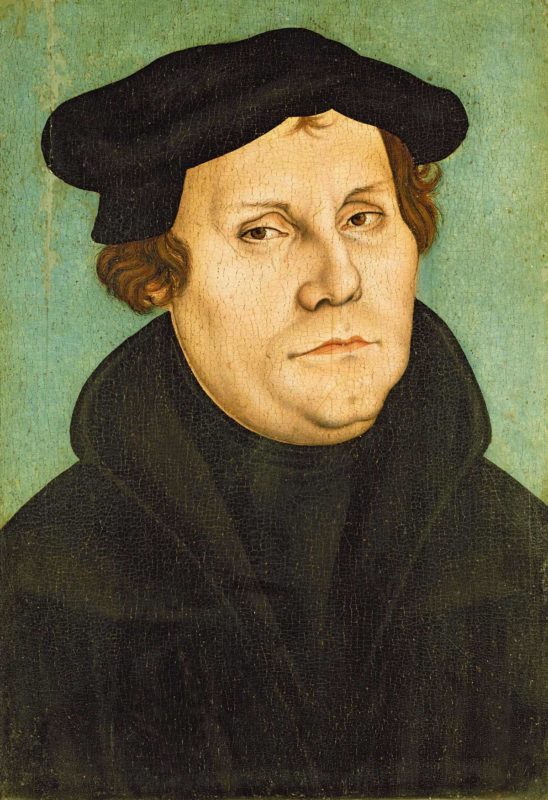
Martin Luther -leader of the Reformation against the Roman Catholic Church
Later in the 1500s the Reformation grew out of this new age of reason of the Renaissance. The Roman Catholic Church had formed as the dominant power and the Pope was more powerful than the States. Martin Luther at this time accused the Church of corruption and exploitation. He led the Protestant Reformation and argued against the right of the Church to coerce people to pay punishments for sins (indulgences) and to buy a ticket to heaven. The poor were abused and suffered. Instead of buying food they handed over the little money they had to the Church for salvation. Martin Luther and the Ninety-Five Theses or the Disputation on the Power and Efficacy of Indulgences was pinned onto Church doors. This action has been cited as the start of the Reformation and the Protestant breakaway from the Roman Catholic Church.
The Church and Art
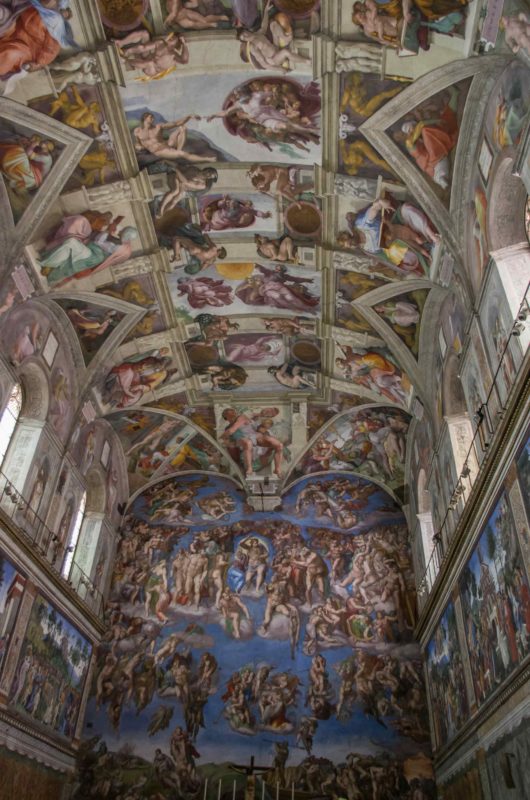
Sistine Chapel Image Antoine Taveneaux 14 June 2014
The Church in Europe has always supported art, especially during the Renaissance. We only need to look at the Sistine Chapel by Michelangelo or the great sculptures and architecture of Rome and Florence to see the patronage of the Church. However, Medieval monasteries with libraries have played a key role too. In caring for books and art and promoting education there is a great legacy left from humble beginnings on a small island in Scotland. The arrival of the Printing Press made an enormous difference to the documentation, delivery and recording of information of course: it changed everything, but no one kept the light burning more than the Monastery monks. Solo figures leaning over desks in a Scriptorium slogging away for centuries must be given credit for their contribution to the knowledge that was preserved.
The artists and scribes have given us beautiful works of art glowing with gold and shining with the light of faith in the human spirit. Quiet hours of successful accomplishment in a quiet place. There is something down to earth and wonderful about the monks from the Medieval monasteries.
References: Age of Faith Time-Life Books by Anne Freemantle, National Geographic World History by Noel Grove. Wikipedia Encyclopedia. Medieval Europe by John Saywell, Clarke Irwin. Heinemann History Ancient & Medieval by R Darlington, V Greer, J Hospodaryk, R Engwerda. St Columba and the Isle of Iona by Ben Johnson Historic UK.
